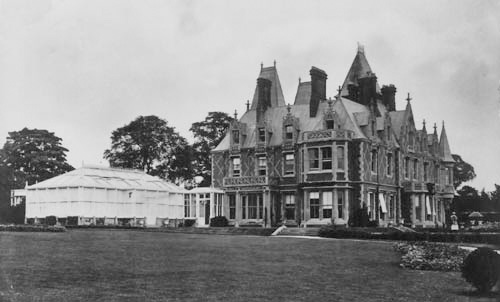Addington Manor
Berkshire
| Location | Addington | ||
| Year demolished | 1926 | ||
| Reason | Replaced by a new house | ||
| See all images: | Gallery | ||
| << Back to the main list |
Despite being one of the select few houses built in a distinctively French château-style, Addington Manor was demolished less than 70 years after it was built.
 The present Addington Manor is the third large house to be built in a village which has averaged only 100 residents over the past 200 years. The original manor house was built on a different site in the village nearby. According to the Domesday Book, the area had orginally belonged to Odo, Bishop of Bayeux and half-brother of William the Conqueror. It passed through various families over the next 800 years and was a headquarters for the Parliamentarians during the Civil War. This house was largely demolished on the completion of the new house.
The present Addington Manor is the third large house to be built in a village which has averaged only 100 residents over the past 200 years. The original manor house was built on a different site in the village nearby. According to the Domesday Book, the area had orginally belonged to Odo, Bishop of Bayeux and half-brother of William the Conqueror. It passed through various families over the next 800 years and was a headquarters for the Parliamentarians during the Civil War. This house was largely demolished on the completion of the new house.
The Addington Manor pictured in the Gallery was built between 1856-57 for John Gellibrand Hubbard (b. 1805 - d. 1889) who was created the 1st Baron Addington in 1887. Governor of the Bank of England between 1853-1855 he was then the MP for Buckingham between 1858 - 1868 and for the City of London between 1858 and 1868. On his death in 1889 he left an estate valued at £111,985 (2007 value - approx. £8.2m).
The house was designed by Philip Charles Hardwick (1822-1892) who was better known for building churches (including Limerick Cathedral). Though his public designs were not very flamboyant, Hardwick's country houses were. Addington Manor was one of several houses which Hardwick created - although he worked on interiors and extensions for several others. Addington incorporated many features seen in his other buildings such as Aldermaston Court in Berkshire (1863) and Madresfield Court in Worcestershire (1863-1885) carrying on a stylistic tradition from his father, Philip Hardwick, who had designed Babraham Hall in Cambridgeshire.
The 2nd Baron Addington was the last to live at the house. He died there in 1915 and during the First World War the house was let as a school. After the War it became a hotel for a short period before being sold to a Mr Smith-Bingham who demolished the house and built the present neo-Classical house, designed by Michael Waterhouse, in 1926.